CHILD SEXUAL HARASSMENT LAW ENFORCEMENT POLICY
Main Article Content
Abstract
Violence against children considers as a violation of human rights as in the Convention on the Rights of the Child. It defines that every child has the right to survive, grow, and be protected from all forms of violence. Every child has the right to respect human dignity, physical and psychological integrity, and equal protection. Child Sexual Harassment is violence committed against children which causes severe physical and mental consequences. It damages committed children in the present and future which considers as a challenging problem in every country and every society. Law enforcement of child sexual harassment must be true protection for child benefit.
This academic article aims to study the condition of problems and flaws of the criminal justice system regarding child sexual harassment. The study has found that problems such as complaints, physical evidence, expert standard, inequality between sexually harassed and sexually accused affect the law enforcement and practice in the prosecution of child sexual harassment cases. So, harassed children are not truly protected for their benefit. It is proposed to have a process such as a medical protection process when a child is being sexually harassed, a social protection process, assistance, and remedy process including the amendment of criminal code for sexual harassment, which conforms to the appropriate forms of offending that changing in today’s society. Thus, the criminal justice system on child sexual harassment can protect the rights of harassed children more effectively.
Article Details

This work is licensed under a Creative Commons Attribution-NonCommercial-NoDerivatives 4.0 International License.
References
กุลพล พลวัน. (3 ธันวาคม 2561). “การล่วงเกินทางเพศ” ความผิดใหม่ในกฎหมายและสังคมไทย. เข้าถึงได้จาก Matichon Online : https://www.matichon.co.th/columnists/news_1254173
จิตติมา ทรงมัจฉา และคณะ. (2555). การประเมินการถูกล่วงละเมิดทางเพศในเด็กและวัยรุ่น: วิธีการประเมินตามหลักฐานเชิงประจักษ์. วารสารสภาการพยาบาล, 27(3), 116-126.
ณัฐ ตันศรีสวัสดิ์ และชินวัต สุวรรณทิพย์. (2549). การรับฟังพยานหลักฐานทางวิทยาศาสตร์. จุฬาลงกรณ์เวชสาร, 50(11), 765-767.
ธีสุทธิ์ พันธ์ฤทธิ์. (2549). กฎหมายลักษณะพยาน. (พิมพ์ครั้งที่ 2), กรุงเทพมหานคร: วิญญูชน.
นพ. วรวุฒิ เจริญศิริ. (ม.ป.ป.). เด็กถูกล่วงเกินทางเพศ. เข้าถึงได้จาก ศูนย์ข้อมูลสุขภาพกรุงเทพ: https://www.bangkokhealth.com/articles
ปกป้อง ศรีสนิท. (2562). การแก้ไขประมวลกฎหมายอาญาเรื่องเพศ: ความหมายใหม่และโทษใหม่ของการข่มขืนกระทำชำเรา. เข้าถึงได้จาก https://www.the101.world/rape-in-thai-law/
พระราชบัญญัติแก้ไขเพิ่มเติมประมวลกฎหมายอาญา (ฉบับที่ 24). (2558). ใน ราชกิจจานุเบกษา เล่ม 132 ตอนที่ 86 ก (หน้า 84-86). กรุงเทพมหานคร: สำนักพิมพ์คณะรัฐมนตรีและราชกิจจานุเบกษา.
พระราชบัญญัติคุ้มครองเด็ก. (2546). ใน ราชกิจจานุเบกษา เล่ม 120 ตอนที่ 95 ก (หน้า 1- 29). กรุงเทพมหานคร: สำนักพิมพ์คณะรัฐมนตรีและราชกิจจานุเบกษา.
พระราชบัญญัติศาลเยาวชนและครอบครัวและวิธีพิจารณาคดีเยาวชนและครอบครัว. (2553). ใน ราชกิจจานุเบกษา เล่ม 127 ตอนที่ 72 ก (หน้า 12-73). กรุงเทพมหานคร: สำนักพิมพ์คณะรัฐมนตรีและราชกิจจานุเบกษา.
ไพโรจน์ วายุภาพ. (2559). ข้อเท็จจริงและการวินิจฉัยปัญหาข้อเท็จจริง. กรุงเทพมหานคร: กรุงสยาม พับลิชชิ่ง.
ยูนิเซฟ. (23 กรกฎาคม 2018). การคุ้มครองเด็ก. เข้าถึงได้จาก Unicef Thailand: https://www.unicef.org/thailand/th/ภารกิจของยูนิเซฟ/การคุ้มครองเด็ก
อานนท์ จำลองกุล. (2560). การดูแลผู้ถูกล่วงละเมิดทางเพศ : ร่างกาย จิตใจ และการเยียวยาทางกฎหมาย. จุฬาลงกรณ์เวชสาร, 61(5), 603 - 618.
Cashmore, J., et al. (2017). The characteristics of reports to the police of child sexual abuse and the likelihood of cases proceeding to prosecution after delays in reporting. Child Abuse and Neglect, 74, 49-61.
Christian, C.W. et al. (2000). Forensic evidence findings in prepubertal victims of sexual assault. Pediatrics, 106(1), 100-104.
Conte, J. R. (2002). Critical Issues in Child Sexual Abuse: Historical, Legal, and Psychological Perspectives. USA: SAGE Publications.
Dias, M. S. et al. (2015). Defining 'reasonable medical certainty' in court: What does it mean to medical experts in child abuse cases? Child abuse & neglect, 50, 218–227.
Faller, K.C. (2003). Understanding and Assessing Child Sexual Maltreatment. USA: SAGA Publications.
Faller, K.C. (2020). The child sexual abuse disclosure controversy: New perspectives on an abiding problem. Child Abuse & Neglect, 99, 1-7.
Fallon Barbara, et al. (2010). Methodological challenges in measuring child maltreatment. Child Abuse & Neglect, 34(1), 70-79.
Giardino, A.P. et al. (2019). A practical guide to the evaluation of child physical abuse and neglect 3rd ed. Heidelberg Germany: Springer.
Harper, J. A. et al. (2003). Examinationfindings in legally confirmed child sexual abuse: It’s normal to be normal. Pediatrics, 94(3), 310–317.
Leserman Jane . (2005). Sexual abuse history: Prevalence,health effects,mediators, and psychological treatment. Psychosom Med, 67(6), 906-915.
London, K. et al. (2008). Review of the contemporary literature on how children report sexual abuse to others: Findings, methodological issues, and implications for forensic interviewers. Memory, 16(1), 29-47.
Runyan, Desmond K. (1998). Prevalence, Risk, Sensitivity, and Specificity: A Commentary on the Epidemiology of Child Sexual Abuse and the Development of a Research Agenda. Child Abuse & Neglect, 22(6), 493-498.
Schaeffer, P. et al. (2011). Children's disclosures of sexual abuse: Learning from direct inquiry. Child Abuse & Neglect, 35(5), 343–352.
Stoltenborgh Marije, et al. (2011). The Prevalence of Child Maltreatment across the Globe: Review of a Series of Meta-Analyses. Child Abuse & Review, 24(1), 37-50.
United Nations. (2015). ASEAN Regional Plan of Action on Elimination of Violence against Children (ASEAN RPA on EVAC). Retrieved from https://violenceagainstchildren.un.org/sites/violenceagainstchildren.un.org/files/document_files/asean_regional_plan_of_action_on_elimination_of_violence_against_children_adopted.pdf
United Nations Human Rights. (1990). Convention on the Rights of the Child. Retrieved from Office of the United Nations High Commissioner for Human Rights (OHCHR): https://www.ohchr.org/EN/ProfessionalInterest/Pages/CRC.aspx
Walsh, W. et al. (2010). Prosecuting child sexual abuse: The importance of evidence type. Crime & Delinquency, 56(3), 436–454.

